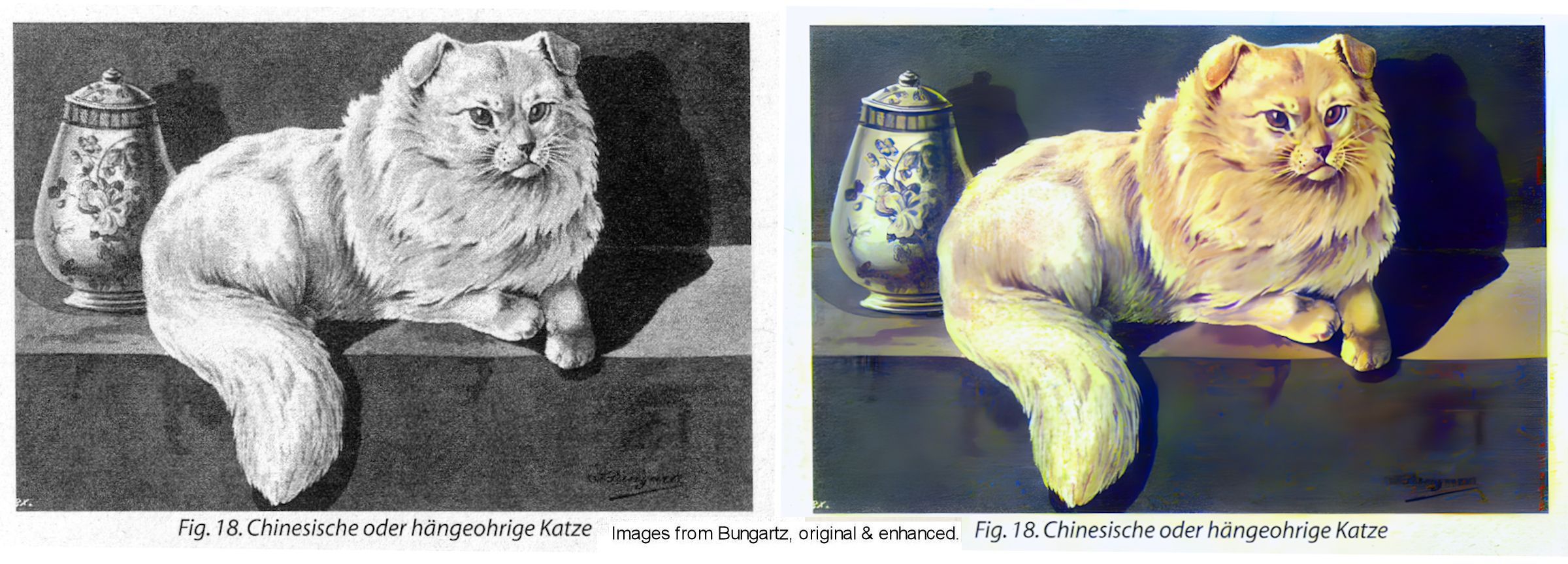
LOST BREEDS - CHINESE LOP
CHINESE LOP

The Chinese Lop-Eared cat, known also (erroneously) as the Sumxu, is now regarded as an extinct cat variety, allegedly once found in the area around Peking, China. It was described as a longhaired cat with a glossy black or yellow coat and pendulous ears. The descriptions derive from a series of mistranslations and the confusion of two entirely different animals! A Polish Jesuit missionary to south China, Michael Boym (ca. 1612-1659), first described the Sumxu in his illustrated book Flora Sinensis (1656) in which he also described Chinese fauna. "Sum Xu" was the Portuguese rendering of songshu, meaning "pine mouse". Though Boym's illustration resembles a squirrel, the description suggests either the Yellow Throated Marten (Martes flavigula) or the Red Panda (Ailurus fulgens) found in the region. Boym wrote that the Sumxu was a pretty yellow-and-black animal that was commonly tamed and wore a silver collar. They were valued as hunters of mice and sold for up to 9 silver coins (indicating their usefulness or rarity). In his "Histoire Naturelle" (?1767, translation 1781 by Smellie), Georges Louis Leclerc, Comte de Buffon, wrote "Our domestic cats, though they differ in colour, form no distinct races. The climates of Spain and Syria have alone produced permanent varieties: To these may be added the climate of Pe-chi-ly in China, where the cats have long hair and pendulous ears, and are the favourites of the ladies [Hist. gen. des voyages, par M. l'Abbé Prevot, tom. 6, p10 ]. These domestic cats with pendulous ears, of which we have full descriptions, are still farther removed from the wild and primitive race, than those whose ears are erect," but he later wrote a supplement saying it might not have been a cat at all, but a different domesticated animal. In his book "Variation of Animals and Plants Under Domestication" Charles Darwin referred briefly to a drooping eared race of cats in China. In "The Cat" by Lady Cust (1870) it states "Bosman relates that in the province of Pe-chily, in China, there are cats with long hair and drooping ears, which are in great favour with the Chinese ladies; others say this is not a cat but an animal called 'Samxces'." During the early days of the cat fancy, there were many attempts to find the lop-eared Chinese breed, and even classes set aside for it in cat shows, but without success.
The Chinese, or Hanging Ear, Cat according to "Die Hauskatze, ihre Rassen und Variet ten" (Housecats, Their Races and Varieties) from "Illustriertes Katzenbuch" (An Illustrated Book of Cats) written and illustrated by Jean Bungartz, published in Berlin in 1896 (There is no published English translation of this book, this gives the gist of the text)
The Chinese or Hanging-Ear cat is most interesting, because it provides proof that by continual disuse of an organ, the organ atrophies. So with the Chinese cat the hearing and/or the ears have deteriorated. Michel says the Chinese, not only admire the cat in porcelain, but also value it for culinary reasons. The cats are regarded as special titbits and enjoyed particularly with chains (noodles?), with rice". This cat is bred particularly for the purpose of meat production, and is a preferred Chinese titbit; this is not unusual if one considers that the Chinese consume much the sight of which turns the stomachs of Europeans. The poor creature is locked up in small bamboo cages and much like a kind of geese fattened with plentiful portions. Extensive trade is carried on with other parts of Asia and the Chinese allow no tomcats to be exported so there is no interference in this lucrative source of income.
Due to the restrictive conditions that have deprived the cat of its actual use, its hearing decreased because it was no longer needed as for hunting its own food. With no need for watchfulness, it was useless to have sharp hearing to listen for hidden things so the hearing became blunt and in natural consequence the ear lost its upright nature, gradually become lower and becoming the hanging ear that is the characteristic feature of the Chinese cat. At first impression this is a surprising and amusing look, but is impression is lost with closer examination. If one ignores the characteristic of the ears, one sees a beauty similar to the Angora cat: a long, close coat of hair, albeit less rich, covers the body. The hair is silky-soft and shining and the colour is usually a light yellow (isabelline) or a dirty white yellow, although some have the usual colouring of the common house-cat. In size it considerably exceeds house-cats and is stronger. The ears hang completely, as with our hunting dogs and are large in relation to cats.
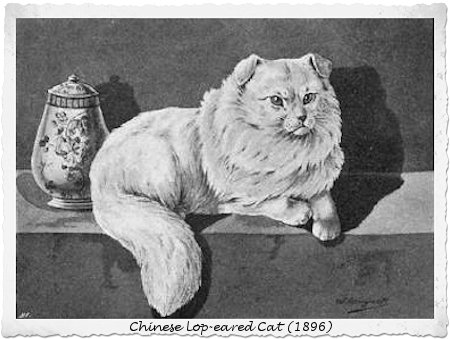
Although the Chinese cat is found in considerable numbers in its homeland, it rarely arrives at European animal markets. Only one such cat has reached us in the flesh; we acquired this years ago when a sailor returning from China brought it into Hamburg. The accompanying illustration is based on this. In character it is like the Angora cat and somewhat inactive. It also prefer to live by a warm fire, is a little sensitive to attention, hears badly and is at its most animated when it sees the milk or food. Apart from its unusual ears, it does not have any really attractive characteristics and is a strange representative of the house cat.
Though reports refer to the Chinese Lop having pendent or pendulous ears (suggesting abnormally long or floppy ears e.g. like a labrador dog) this is probably an exaggeration. In all likelihood, and in the absence of any current examples or pictorial evidence, the ears were folded in a manner similar to the Scottish Fold. In Frances Simpson's "The Book of the Cat" (1903), contributor H C Brooke wrote "There is said to be a variety of Chinese cat which is remarkable for its pendent ears. We have never been able to ascertain anything definite with regard to this variety. Some years back a class was provided for them at a certain Continental cat show, and we went across in the hope of seeing, and if possible acquiring, some specimens; but alas the class was empty! We have seen a stuffed specimen in a Continental museum, which was a half long-haired cat, the ears being pendent down the sides of the head instead of erect; but do not attach much value to this."
In 1926, Brooke wrote that "for donkey's years" Continental cat shows had offered prizes for the Drop-eared Chinese Cat. On each occasion, the cat failed to materialise and Brooke considered it to be mythical. Other writers suggested it was the result of haematomas causing the ears to fold or crumple. Brooke noted that although no-one ever saw the cat itself, one always met "someone who knows someone whose friends has often seen them". In an April 1927 issue of Cat Gossip, he wrote: "The mystery of the Chinese Drop-eared eats will, we fear, never be solved. We are beginning to think that the Chinese gentleman whom we met once and who assured us with a smile that was childlike and bland, that he knew them well, was indulging in terminological inexactitudes. [ ] On the face of, a cat with hanging ears seems most unlikely. Yet when we consider the extraordinary modification domestication has effected in the dog and the rabbit the wonder seems rather that the cat has remained for thousands of years unaltered. We have inquired of naturalists all over the globe; of the Chinese Embassy, of Hagenbeck s the great Hamburg animal dealers; of a certain well known author who has lived for years in China and knows that country well; The American Express Cohave very kindly instructed their representatives at Shanghai and Peking to make inquiries, without result. Animal dealers in Shanghai, they say, do not believe in the existence of such a cat. None of our wild animal dealers know it. Against this we have the detailed description given by the German naturalist, Brehm, last century - and he was usually very accurate - and the fact that forty-five years ago we saw a stuffed specimen, half coated with yellowish white fur in a Continental museum! This, however, we have always thought might be a fake or a cat with its ears deformed by canker and possibly presented in all good faith. At any rate, we are afraid the Drop-eared cat, if ever existed, is now extinct. This fate has overtaken many interesting local races, usually from their characteristics being bred out by mixing with common strains. For instance, we doubt if any pure specimens now exist of the remarkable Phu-Qoc or Fu-Oc Dog the hair on whose hack grew pointing towards the head [possibly now represented by the Thai Ridgeback]. Whilst of the New Mexican Hairless Cat, specimens of which were yet alive in 1900, absolutely no record seems to exist, here or in New Mexico, except the photo and description we were fortunate enough to secure for science."
H.C. Brooke was able to report more about the Chinese Lop in his magazine Cat Gossip on 11 May 1927. In an article entitled The Chinese Drop-Eared Mystery by Joan Conquest, the following was reported In reply to your inquiry as to the Drop-Eared Chinese Cat, I wish I could help you, but, unfortunately, I have never come across such a cat in China. I did, however, see a mural painting in, I think, the Central Provinces, of a panther or maneless lion with just such ears. A big beast, crouching on a bough and snarling. But just where 1 saw it I do not remember. I remember saying to my boy that the animal had broken ears. That seems rather like the beast referred to in The Catalogue of Carnivora, doesn't it? (A Catalogue of Carnivorous Animals in the British Museum, Gray, about 1860). I will write to my friend, Dr. Giles, of the British Museum, and ask him if he knows anything about the actual cat. I expect you know about the beautiful long-haired present-day Chinese Cat. Very difficult to get hold of. One puts one s name down for a kitten as one does for a club over here. A treacherous beast it is, too.
Note by Editor. Although not containing the hoped-for information. Miss Joan Conquest's letter is the most informative reply we have received to our inquiries about the Drop-Eared Cat made all over the world. If it does nothing else, it at any rate does definitely lift the drop or hanging-eared feline out of the category of mere travellers' tales. We now ask ourselves Was the story of such a cat, repeated by almost every naturalist since the days of Buffon and Brehm, based upon this, or similar Chinese paintings, of an imaginary or mythical animal; or did those paintings represent an animal which really existed even if now unhappily extinct as the Dodo?
This was followed up in Cat Gossip on 18 May, 1927 in More About Chinese Cats by the same author: In the hope of obtaining further information for you as to these cats, I have inquired of Dr. Giles, at the British Museum, and he has turned up every reference book in the Museum, but without result. He suggests the Natural History Museum, but that, of course, you have tried. A Buddhist priest took me round the Temple where I saw the Drop-eared feline as a mural painting. The painting was in a room behind the high altar. A dusty place, with an enormous Buddha at the end. The cat was life-size, and lying on a branch snarling. I forget the exact place, but I believe it was up Kalgan way, towards Mongolia. I have seen so many Temples, so many mural paintings, especially of felines, notably in Japan. In my travels I have only come across the ordinary felines.
About the Long-haired Chinese Cat. It originated, I was told, in the Province of Hou-an, and has been domesticated from the wild cat. A friend of mine had one, a perfect beauty. Red. A tremendous ruff and a colossal tail, which it carried straight up after the manner of all Chinese Cats. Blue eyes, and the most devilish temper. The eyes were long and slightly slanting at the outside corner. Thev are greatly prized because of their beauty, and very difficult to get. I had a common Chinese White Cat, as a kitten. She presented me with four kittens. Father unknown, but I thought probably a big ugly black creature which used to roam my roofs. Two of the kittens were common black and white cats; the other two, my Boy said, were Hou-an Cats. A light and dark tabby. One with blue eyes, which remained blue; and the most tremendous coats and tails. A throw-back, I suppose? I wish I could help you further.
In response to the requests for information on the cat, a lady in Worthing wrote to Cat Gossip (August 31, 1927) to say there was one, but a British cat, in Worthing, England. The cat was owned by a Mrs Drage and was about 13 months old at the time of writing. The description says that the ears had always been the same ever since she had it as a young kitten. "The ears are not very long, but the tips appear exactly in line with the top of the base of the ear."
The last reported sighting of the Chinese Lop seems to have been in 1938 when a droop-eared cat was imported from China. On that last occasion the mutation was thought to be restricted to white longhaired cats. It is hard say for certain whether these were isolated cases or whether the Chinese Lop was a genuine variety. It cannot even be said with certainty that the trait was an inherited one. The exact conformation of the Chinese Lop, if it truly existed, cannot be established, but the general type is probably represented by the Scottish Fold and its derivative breeds.
The German naturalist, Brehm, had given a very detailed description of the cat in the 1700s. Brehm was usually very accurate. In 1882, Brooke had seen a stuffed specimen in a Continental museum. The specimen was "half-coated with yellowish fur". He admitted that it might have been a fake or a cat with its ears deformed by canker (i.e. cauliflower ears) that had been presented in all good faith. All avenues of enquiry exhausted, Brooke declared the Chinese Drop-eared cat extinct. The last reported sighting of the Chinese Lop seems to have been in 1938 when a droop-eared cat was imported from China. On that last occasion the mutation was thought to be restricted to white longhaired cats. It is hard say for certain whether these were isolated cases or whether the Chinese Lop was a genuine variety. It cannot even be said with certainty that the trait was an inherited one.
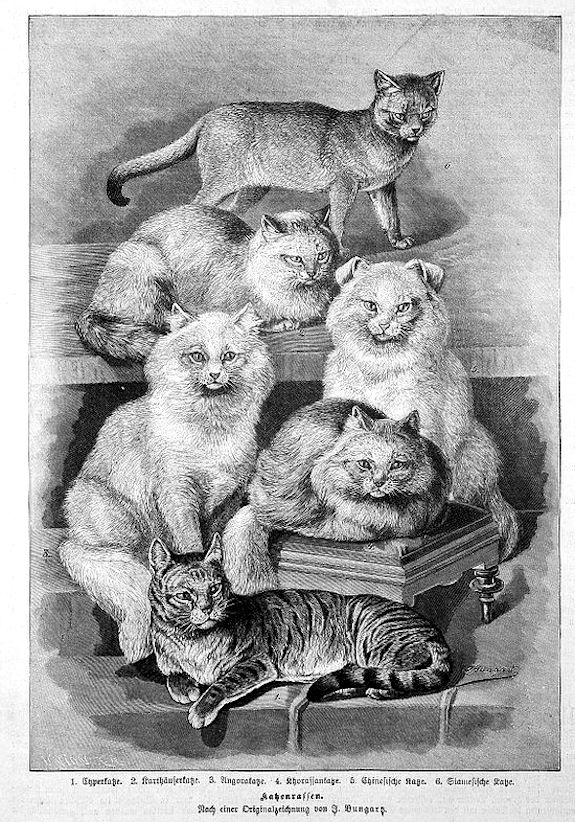
If confusion between a cat and a marten or red panda seems far-fetched, a ring-tailed lemur was once exhibited at a cat show as atype of cat.
Confusion between Lop-Eared Cat and Yellow-Throated Marten or Red Panda
How did the Sumxu name end up attached to a variety of cat? To begin with, the Sumxu probably only ever existed in the form of illustrations, not in reality.
The sumxu first appeared in Europe - as a woodcut in the treatise Flora sinensis (Vienna, 1656), written and illustrated by the Polish-Lithuanian Jesuit missionary to China, Michael Boym (1612 1659) and was treated as a real creature by subsequent generations of naturalists until the late nineteenth century (during which time it became conflated with the Chinese Lop-Eared domestic cat). Because no-one had ever seen it in the flesh, the images and descriptions of this animal evolved as they were copied from Boym and then from his copyists. The print in Flora sinensis depicted a small-sized furry creature with a stout body, long tail, stocky limbs and rounded head. It is chasing an animal that is identified in both Chinese and Latin text as a green-winged turtle (Viridium alarum testudo). The furry creature is identified in Chinese script as songshu and phonetic Latin as sumxu. It was accepted as fact and copied into later natural history texts. For Europeans, the Flora sinensis, with its engravings of 21 plants and 8 animals, was one of the earliest visual renditions of the south-east Asian fauna. The Chinese name songshu translates as squirrel or pine mouse, though it did not look like the familiar European Red Squirrel which does not hunt mice.
Several unillustrated accounts of Chinese flora and fauna existed in Europe before Boym s work, but the engravings in Flora sinensis caught the eye of naturalists. The descriptions of animals in the Flora sinensis mostly followed normal conventions: appearance, behaviour and distribution, sometimes followed by its usefulness to man. The illustration of the sumxu was rather primitive compared to Boym s detailed illustrations of other flora and fauna.
The Latin name for green-winged turtle was given, but there was no Latin name for the sumxu, only the phonetic rendering of the Chinese characters and a description The Sumxu is an animal from China; coloured yellow and black, and of beautiful appearance. The Chinese tame this animal and make it wear a silver collar. It is an excellent hunter of mice. They often cost seven to nine scudi. [Sumxu animal apud Sinas reperitur, flavi & nigri coloris est, pulcherrimi aspectus. Cicurant illiud Sinenses & collum argento exornant, mures egregri venatur. Saepe venit septem & novem scudis.] Boym s coloured image showed the sumxu in yellow-brown; most copies of Flora sinensis contain monochrome engravings.
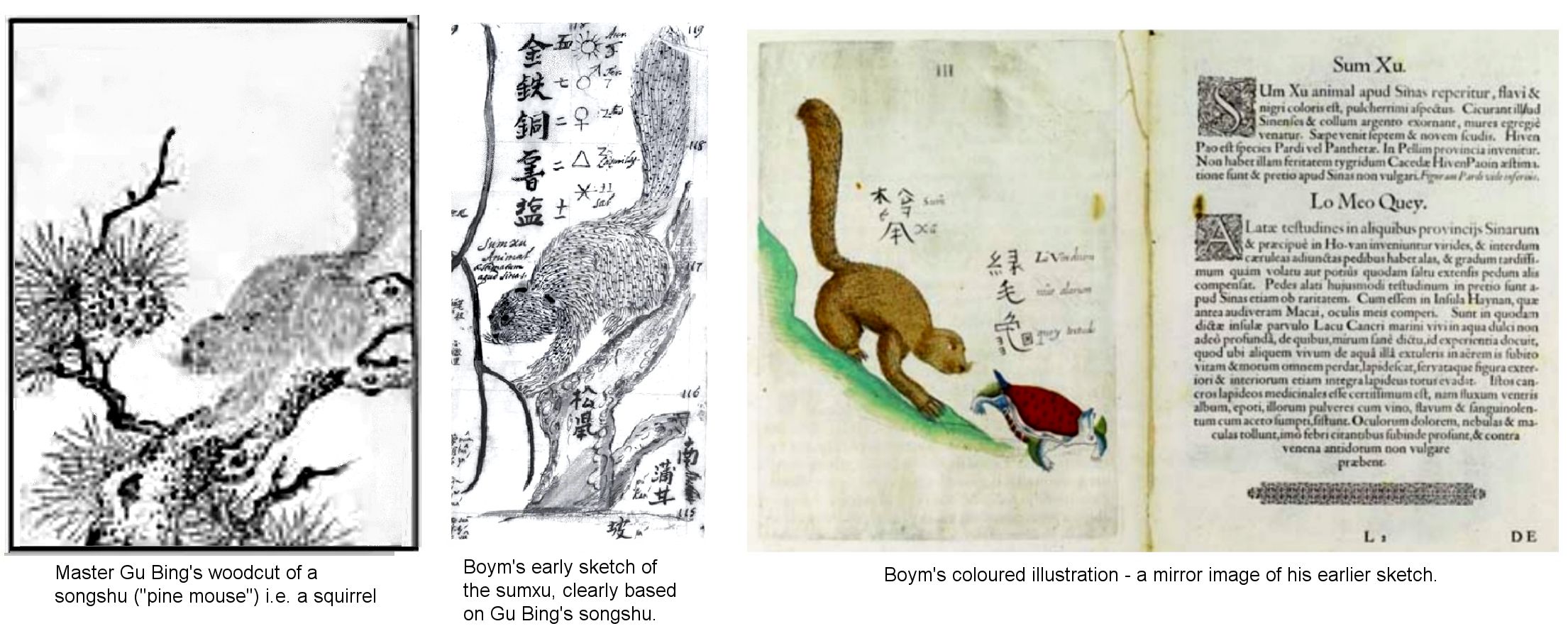
Boym did not say whether he had seen dead specimens or had relied on oral descriptions or illustrations in Chinese printed compendia. Though fluent in Chinese, he may have referred to this unknown animals as a squirrel based on the Chinese taxonomy where shu (mouse) referred to rodents, martens and mongooses. In trying to make sense of Chinese information, he might have amalgamated several descriptions and images into a single animal. Boym sent his original sumxu drawing to printers in Vienna, but it has since been lost.
Boym had also produced an atlas of China comprising eighteen maps of Chinese provinces, each with a sketch of a regional animal or plant. There is a marginal sketch of a sumxu on his map of Yunnan province, which looks like a Westernised version of a woodcut of a squirrel in Master Gu Bing s Catalogue of Painting. Because the sumxu appeared in Boym s respected book of Chinese flora and fauna it was accepted as fact by other naturalists. The description of a black and yellow animal matches many species known to the Chinese, including the Mongoose, the Yellow-throated Marten, the Red Panda, and the Indian Giant Squirrel (which might have been imported as an exotic, and expensive, pet). The Marten and the Mongoose were used for hunting mice and snakes respectively in some countries, but when a black-and-yellow animal was described as a mouser, western Europeans would immediately have thought of tabby or tortoiseshell cats. Some editions and translations of Flora sinensis omitted the unidentifiable sumxu.
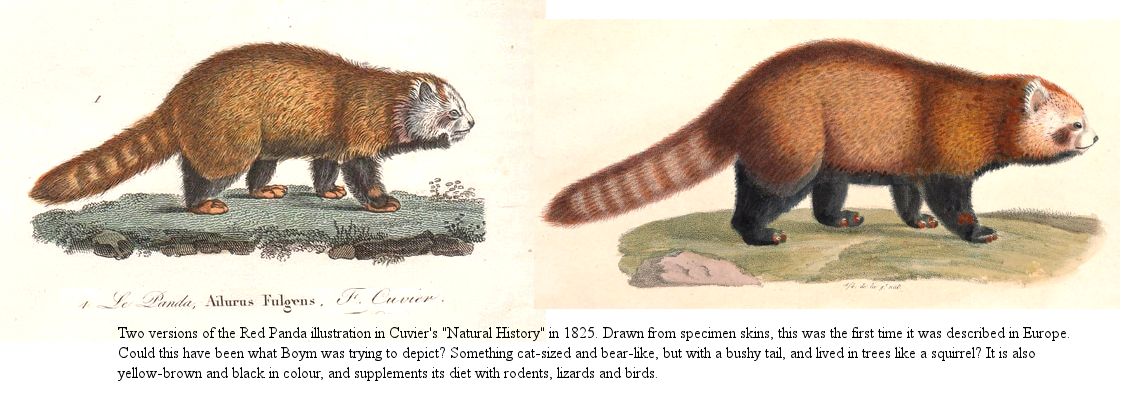
The sumxu is described as saffron and black and shown by Boym as characteristic of Yunnan province, and there is a creature that matches this description: the Red Panda (xiaoxiongmao - small bear-cat ). It is cat-sized, has a long, fluffy striped tail and cat-like face. Mount Gaoligong in northwest Yunnan is one of its habitats. Boym may not have seen one in the flesh, but could have heard about it and tried to make sense of descriptions of a creature that cat-like, bear-like, lived in trees like a squirrel and was reddish with black underparts. Being rare, it was valuable, and it has been kept as a pet. Although usually described as vegetarian, red pandas hunt birds, reptiles and rodents.
(The first known written record of the red panda was a 13th-century Chinese scroll depicting a hunting scene between hunters and the red panda, but compared to other animals it seems rare in Chinese art, so Boym would not have had a visual reference. The red panda was not formally described by Europeans until 1825 by Frederic Cuvier, whose description was based on preserved skins and parts sent to the Paris Museum of Natural History by Alfred Duvaucel (Histoire naturelle des Mammiferes, avec des figures originales, coloriees, dessinees d'apr s des animaux vivans: puble sous l'autorite de l'administration du Museum d'Histoire naturelle). It had been described earlier by Thomas Hardwicke in 1821, but his paper was not published until 1827.)
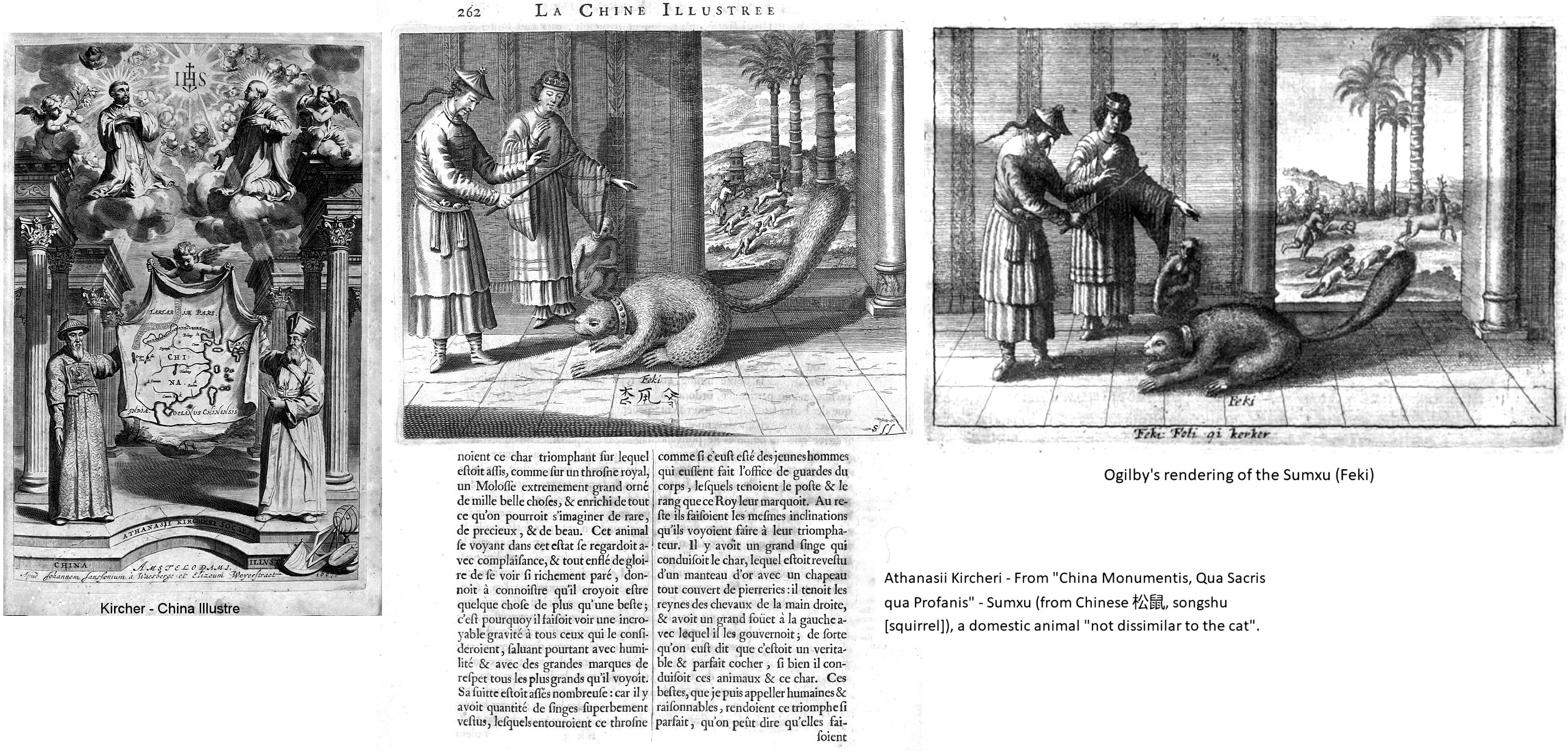
This engraving is from German Jesuit Athanasius Kircher's book "China Monumentis, Qua Sacris qua Profanis" (1666) (also called China illustrate (1667)). Kircher re-drafted Boym s illustration so that the sumxu (also called Feki) became part of a western-style engraving. Boym s drawing hadn t given an indication of size so the creature, while similar in conformation to Boym's illustration, was the size of a small bear and, in the background, is shown chasing deer, rather than mice! The book is written in Latin and describes the Sumxu as being like a cat. Kircher was a scholar rather than a missionary and he relied on the expert knowledge of those who had travelled to China, such as Boym and one of Kircher's former students, Martino Martini. Kircher wrote; There is also a domestic animal called the Sumxu, which is similar to a cat. It is black and saffron coloured and has splendid hair. The Chinese tame it and put a silver collar around its neck. It is an avid hunter of mice. It is so rare that one sells from seven to nine scudi. This was a high price. Because it was an avid hunter of mice, Kircher compared it to the familiar cat (he could equally well have compared it to the domesticated ferret) and by making this comparison, Kircher began the evolution of the squirrel-like sumxu into the lop-eared cat.
While Kircher may have used Martini s Novus atlas sinensis (Amsterdam, 1655) as a source for a description of a mouse-hunting creature from China, Martini was describing a quite different lop-eared white cat from the Peking region, not a black and yellow creature. Chats dont on fait beaucoup d tat. Dans cette Province il y a des chats tous blancs, qui ont le poil long, les oreilles pendantes, qu on estime comme ces petits chiens de Malte, & que les Dames aiment extrement: mais ils ne prenent point de souris, cause, peut estre, que ces Dames les nourrissent trop delicatement: ils n en manque pas pourtant du ceux qui chassent fort bien aux souris, bien qu on ne les mignarde pas tant; ce qui les rend peut estre meilleurs que les autres. [Cats that are held in high esteem. In this province there are cats white all-over, who have long fur, and floppy ears. They are esteemed as highly as the little dogs of Malta, and the Chinese ladies love them dearly. These cats are not good mousers, perhaps because these ladies nourish them too delicately. The Chinese do not lack however in those cats that hunt mice well, although they are not treated as preciously; maybe this makes them better [hunters] than the others.]
Kircher s book becomes confused. The term Feki seems properly to belong to the monkey-like animal shown in the engraving: There are also in China several types of man-like apes. Some have no tails, but others have tails like dogs or cats. They are very docile and except for the foulness of their bottoms, you would scarcely believe they were animals. Elsewhere in his book he calls these Feki. They seem to be macaques or baboons which were sometimes kept as pets and trained.
John Ogilby s abridged translation of Kircher s work, published in London, had a different set of illustrations as the original engraving plates were not available to him. The monkey got a more macaque-like face, but the Sumxu/Feki remained confusing. Ogilby included the passage about the Feki, but omitted the Sumxu, presumably unable to match it to the illustration. Some authors simply reproduced the description of the sumxu (or xumxu) and left the reader to imagine its appearance.
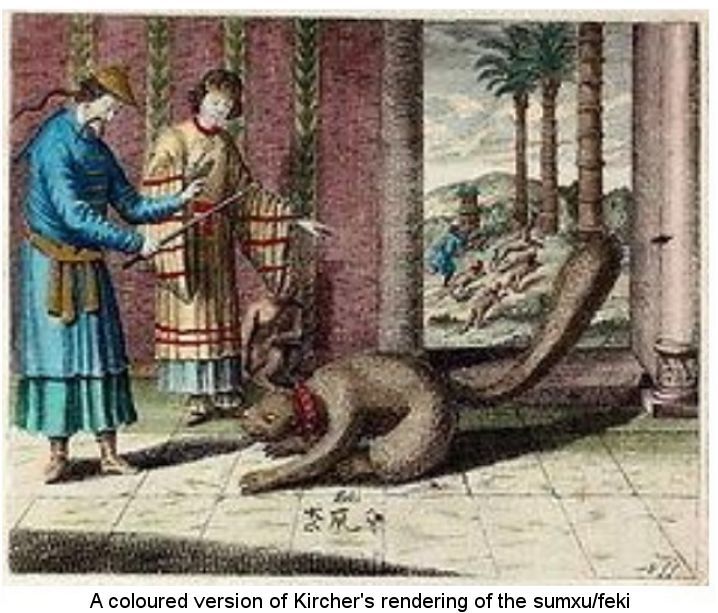
Italian Jesuit Martino Martini had visited China in the 1650s and published Novus Atlas Sinensis in 1655. In the section on Peking Province, Martini described a race of white, long-haired and long-eared cats found in the region. He wrote that the cats in that province were white all over with long hair and long ears like lap-dogs and that these well-fed cats did not catch mice, but were ladies' lap-cats. Martini became the definitive source of information about China and his description was used in 1673 by John Ogilby and by others who described the long-eared, milk-white cats as being companions and not hunters (there being other cats that were good mousers). The cats were likened to the Maltese lap-dog and to spaniels. It retrospect, it is likely that these white cats were also blue-eyed, a combination of traits associated with deafness in cats - quite likely they couldn't hear the mice in order to investigate mouse bolt-holes! If this was the same mutation as the Scottish Fold, it is associated with sometimes crippling changes to the tail, hind legs and vertebrae which would make an affected cat reluctant to move around.
In 1736-37, Martini's work was superseded by that of French Jesuit du Halde's works on the Chinese Empire. This compiled material from French Jesuits and re-used some of Martini's book, including the description of the long-eared white cats: "Among the animal species one finds singular (i.e. unique) cats which the Chinese ladies seek out to provide them with amusement and feed with plenty of delicacies: they have long fur and drooping ears." This remained the standard reference book for many years and was reused by other authors, including the passage about the lop-eared cats. For example John Green's book described the lop-eared cats of Peking Province as "a particular Sort of Cats, with long Hair, and hanging Ears, which the Chinese Ladies are very fond of." This was later translated back into French by abb Prev t as "among the animals one finds a singular species of long-haired cats with hanging ears, which the Chinese ladies greatly liked."
In volume 4 of his "Histoire Naturelle" (?1767), Georges Louis Leclerc, Comte de Buffon, wrote "The Natural History of The Cat". Buffon noticed that, unlike the many breeds of dog, there were few distinct races of domestic cat: Spanish, Syrian and Khorasan (Persian). He believed the long-haired lop-eared Chinese cat could be a fourth distinct type. "They (cats) are in nature much more constant, and their domesticity is not as complete nor as universal as that of the dog, so it is not surprising they are less varied in type. Our domestic cats, though different from each other in colour, do not form distinct and separate races. Only the climates of Spain, Syria or Chorazan (Persia) have produced constant varieties; to find another, one must join the climate of the province of Pe-chi-ly (Northern Zhili) where there are cats with long hair and hanging ears, much liked by the Chinese ladies." Buffon was translated into English in 1781 by William Smellie. According to Buffon, "Our domestic cats, though they differ in colour, form no distinct races. The climates of Spain and Syria have alone produced permanent varieties: To these may be added the climate of Pe-chi-ly in China, where the cats have long hair and pendulous ears, and are the favourites of the ladies. These domestic cats with pendulous ears, of which we have full descriptions, are still farther removed from the wild and primitive race, than those whose ears are erect."
In a supplement, Buffon added that there was some doubt as to whether the Sumxu was a cat or some other animal: "I formerly remarked, that, in China, there were cats with pendulous ears. This variety is not found any where else, and perhaps it is an animal of a different species; for travellers, when mentioning an animal called Sumxu, which is entirely domestic, say, that they can compare it to nothing but the cat, with which it has a great resemblance. Its colour is black or yellow, and its hair very bright and glittering. The Chinese put silver collars about the necks of these animals, and render them extremely familiar. As they are not common, they give a high price, both on account of their beauty, and because they destroy rats."
Buffon's source was Prevot, whose source was Green, whose source was de Halde, whose source was Martini's 1655 work. Buffon noticed a process we now call neoteny - domesticated animals retain juvenile features into adulthood. Thus wolves ahd pricked ears and domestic dogs often had softer, hanging ears. Buffon believed this could apply to cats as well and that the mild climate and ancient civilisation of China was conducive to domestic cats developing a similar trait to domestic dogs. In his work, Buffon also mentioned the sumxu as a pretty domestic animal of China, not unlike a cat. In his Vol VIII (published 1777), Buffon goes so far as to suggest the lop-eared cat of China is a different species from the ordinary domestic cat and that it might therefore be the cat-like sumxu:
Misled by comparisons to cats, Buffon suggested the Sumxu could be the Chinese lop-eared cat reported by many European natural historians: Nous avons dit (volume VI, page 14) qu il y avoit la Chine des chats oreilles pendantes; cette vari t ne se trouve nulle part ailleurs, et fait peut- tre une esp ce diff rente de celle du chat, car les Voyageurs parlant d un animal appel Sumxu, qui est tout- -fait domestique la Chine, disent qu on ne peut mieux le comparer qu au chat avec lequel il a beaucoup de rapport. Sa couleur est noire ou jaune, et son poil extr mement luisant. Les Chinois mettent ces animaux des colliers d argent au cou, et les rendent extr mement familiers. Comme ils ne sont pas communs, on les achette fort cher, tant cause de leur beaut , que parce qu ils font aux rats la plus cruelle guerre. [We have said (volume six, page fourteen) that there were lop-eared cats in China; this variety is found nowhere else. Perhaps it is a different species altogether because travellers speak of an animal called Sumxu, which is domesticated in China. They say that it can be best compared with the cat with whom it has much in common. It is black or yellow in colour, and its fur is extremely shiny. The Chinese put silver collars on these animals neck to tame them. As they are not common, they sell at a high price, both because of their beauty and because they make the most cruel war against rats.]
This seems a big leap (and an erroneous one) from Boym's black-and-yellow squirrel-like creature to Martini's white lop-eared cat, however du Halde had omitted to mention in his compilation that the lop-eared cats were milk-white! While Boym's sumxu was valued as an avid mouser, Martini's lop-eared white cats were not interested in mice and were kept as lap-cats, another piece of information du Halde omitted in his compilation. Boym's illustration of the sumxu ignores its ears, while Martini described them as the defining feature of the white cats. Boym didn't liken the sumxu to cats and it is Kircher who made that comparison. The sumxu was a creature of south China while the lop-eared cats were from Peking Province in the north. Buffon's leap was further misinterpreted by later authors such as French zoologist and writer Anselme Ga tan Desmarest who combined the name "sumxu" with the description of the lop-eared cat (its white colour being unknown to him). In 1820, Desmarest stated in Mammalogie ou description des esp ces de mammiferes that the lop-eared cat of Peking and the sumxu were the same species. Desmarest included the sumxu in his list of cat breeds. La 2e. est le chat d'oreilles pendantes, poil fin et long, noir ou jaune, en domesticit la Chine, dans la province de Pe-chi-ly, sous le nom de sumxu. [The second is the hanging-eared cat, fur long and fine, black or yellow, domesticated in China in the province of Pe-chi-ly, [Peking province] known by the name of sumxu.] This error was perpetuated through the 19th and early 20th centuries, especially by cat fanciers looking for new and exotic cats to import.
In 1856, Lady Cust described this creature in her book The Cat: Its History and Diseases but she is quoting from Bosman s Voyage de Guinee. : 'Bosman also relates that In the province of Pe-chily, in China, there are cats with long hair and drooping ears, which are in great favour with the Chinese ladies: others say this is not a cat, but an animal called Samxces. Writing of the drooping ears, he further adds, It is worthy of remark that there is in animals evident signs of ancestry of their slavery. Long ears, varied colours, long and fine hair, are effects produced by time and civilization, whilst all wild animals have straight, round ears [. . .] I am doubtful the ears of cats or any of the feline race ever would fall, as their hearing would then be less acute and not so well suited to their habits of life.'
When China was forced to reopen its borders to foreigners after the Opium Wars, a number of missionaries, entrepreneurs, cat fanciers and researchers went looking in vain for the lop-eared cat. In his book "Variation of Animals and Plants Under Domestication" Charles Darwin referred briefly to a drooping eared race of cats in China. The zoologist and Catholic priest, Armand David went in search of the lop-eared cat. In 1889, he wrote a report on China s wild and domestic cats, in which he concluded that no Sumxu was to be found: Jamais nous n'avons rencontr la race oreilles tombantes dont on a parl beaucoup, il y a quelque temps. - Armand David, Faune et flore chinoises: Classe des mammif res, ordre des carnassiers , Les missions catholiques 21, no. 1040 (10 May 1889). [ We have never encountered the breed with drooping ears of which much has been said some time ago. ]
In his 1885 book "The Cat: Natural History, Husbandry ["Hygiene"] and Illnesses" Gaston Percheron suggested the lop-eared cat might be a hybrid between the cat and a marten: "Certain respected naturalists even claim even that the [domestic cat] mates with the marten and produces among the hybrids those like the latter in colour and fur. In this way they explain the hanging-ear cats of China [...]" but instead of being fed delicacies by its mistress, the cat has become a delicacy to be eaten, "The Chinese Cat. It has long, silky hair and hanging ears, like those of a badger. Its flesh is highly esteemed by the inhabitants of the Celestial Empire. As with the dog, it is treated with great solicitude by feeders and fatteners of this country and when it is fattened, it appears alongside swallows' nests on well-served tables. " As a side-note, in 1926, Siamese cat fancier Lilian J Veley remained adamant that Siamese cats were not merely a form of domestic cat, but resembled an unknown type of viverrine that lived in the region (the most likely contender again being the Yellow Throated Marten) in their sable-and-dun colour and "marten-like" face! Maybe "Sumxu" and "Siam" sounded similar to her ears.
In volume 4 of his "Histoire Naturelle" (?1767), Georges Louis Leclerc, Comte de Buffon, wrote "The Natural History of The Cat". This was translated into English in 1781 by William Smellie. According to Buffon, "Our domestic cats, though they differ in colour, form no distinct races. The climates of Spain and Syria have alone produced permanent varieties: To these may be added the climate of Pe-chi-ly in China, where the cats have long hair and pendulous ears, and are the favourites of the ladies [Hist. gen. des voyages, par M. l'Abbé Prevot, tom. 6, p10 ]. These domestic cats with pendulous ears, of which we have full descriptions, are still farther removed from the wild and primitive race, than those whose ears are erect. " In a supplement, Buffon added "I formerly remarked, that, in China, there were cats with pendulous ears. This variety is not found any where else, and perhaps it is an animal of a different species; for travellers, when mentioning an animal called Sumxu, which is entirely domestic, say, that they can compare it to nothing but the cat, with which it has a great resemblance. Its colour is black or yellow, and its hair very bright and glittering. The Chinese put silver collars about the necks of these animals, and render them extremely familiar. As they are not common, they give a high price, both on account of their beauty, and because they destroy rats [Journal des Savana, tom. 1. p261]."
The Polish diplomat and writer Edward Kajdanski s book Michael Boym, an Ambassador of the Middle Kingdom" (1999) has a chapter on Boym s Flora Sinensis. Kajdanski refers to the "sumxu cat" ("kot sumxu") even though Boym didn t call it a cat, and Kircher merely compared it to a cat. Through a convoluted argument, Kajdanski links the origin of Boym's sumxu-and-turtle picture to a supposed fascination with Marco Polo. Marco Polo s Travels mentioned the musk deer, which some editions referred to as cat-sized. Kajdanski suggested that Boym went in search of a cat-sized musk-producing animal and ended up depicting a civet (sometimes called civet cat) which he called a sumxu. Kajdanski claimed to have seen such a creature in the Natural History Museum of Kunming, but could not find out its Latin name.
Kajdanski linked the name sumxu not to songshu but to shi-she-shu (transcribed as xixexe or shuxexu) the snake-eating mouse from Ben Cao Gang Mu s compendium of medical knowledge, which Boym would have been familiar with. The snake-eating mouse appears to have been a mongoose sent from India as a tribute, and therefore valuable. The shi-she-shu was supposedly able to sniff out venomous snakes; its own musky smell could repel venomous snakes from the place where it was kept; and mentioned by Ben Cao Gang Mu if its owner was bitten by a snake, he only had to have his shi-she shu urinate on the bite wound, and it would save him from the snake s venom.
Despite all evidence to the contrary, some people continue to believe in a lop-eared sumxu cat. In Nancy Robbins self-published Domestic Cats: Their History, Breeds and Other Facts (2012), 265 266 she claims it used to exist but became extinct. The Sumxu, Chinese Lop-Eared Cat, Drop-eared cat, Droop-eared cat, or Hanging-Ear Cat, all names referring to its characteristic feature of pendulous ears, was a long-haired lop-eared breed of cat now considered extinct [. . .] An engraving from Athanasius Kircher s book China Monumentis, Qua Sacris qua Profanis (1666) describes the Sumxu as cat-like, but the illustration resembled a small bear with a bushy tail. The engraving was probably based on verbal descriptions of sketches since other writers refer to the creature as a droop-eared cat.